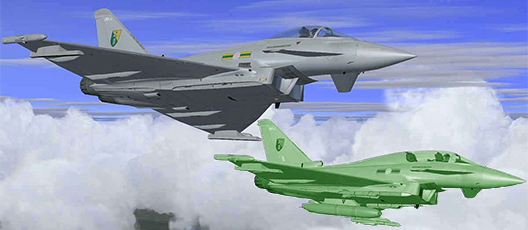Aerospace

Synthetic Weather For A Simulation Environment
Current flight simulation systems do not have the capability to replicate the environment with a high enough level of fidelity for this to be used within networked (Real Aircraft and Simulated Aircraft) flight training.
The generation of correlated high-resolution synthetic meteorological conditions in order to allow ground based simulators to experience the same environment as (networked) real aircraft flying in the same battlespace is an important requirement, which will allow advanced flight training to be realised.
A – Research Areas
The research being undertaken aims to identify and resolve the problems that occur when trying to integrate simulated aircraft and real aircraft for training exercises.
-
Atmospheric factors have been identified as an important issue within the training environment; not being able to reproduce these accurately could lead to negative training being incurred.
-
The communications network will need to be expanded and improved in order to accommodate the transfer of information between the training parties. (Simulated aircraft, Server and Aircraft).
- Visualisation techniques, level of immersion and aircraft display systems shall need evaluating / modifying to ensure they can manage the new level of fidelity desired.
B – Immediate Environment
A large array of sensors already exist that detect environmental conditions, however the ability to detect the position of clouds, wind and visibility (accurately) is still in its formative years.A visibility, wind and precipitation detection system (VWPDS) will function to sense the immediate environment of the aircraft. Radar, satellite imagery, an onboard camera system and aircraft real time data will be utilised to create a three dimensional local- area map of the environment.
C – System Overview
The diagram below outlines how a synthetic weather environment can be achieved. The sources of information displayed at the bottom of the diagram will be used to build up a foundation ‘image’ of the environment. Both weather and positional information will be relayed from real aircraft which will enable the synthetic environment to achieve a high level of realism. The central server will be used to integrate all the available sources of information, as well as relay the relevant information to potentially multiple aircraft (both real and simulated).
Research Key Benefits
Realising the aims and making the required breakthroughs in the areas detailed in this poster will allow for training situations that were previously only able to be experienced in real air space, to be partly experienced within a simulation environment. This will allow multiple training benefits to be achieved:
- Safety – Reduce risk in dangerous manoeuvres.
- Equipment – Minimise use of expensive resources.
- Cost – A cost efficient solution.
- Time – Reduction in preparation time.
- Reporting – Automatic production of scoring and information.
Pilot training is increasingly complex, with all costs (not just monetary) potentially rising; hence, the development of a system capable of sensing, storing and distributing the immediate environment of networked real aircraft would hugely impact the future of pilot training.
Want to know more?
Email d.j.friend@lboro.ac.uk, call 01509 63 5673 or visit http://avrrc.lboro.ac.uk
Download a pdf containing this information
